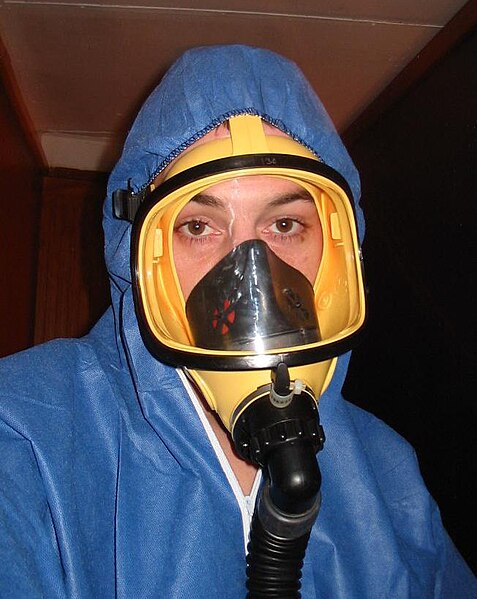Powered air-purifying respirator
A powered air-purifying respirator (PAPR) is a type of respirator used to safeguard workers against contaminated air. PAPRs consist of a headgear-and-fan assembly that takes ambient air contaminated with one or more type of pollutant or pathogen, actively removes (filters) a sufficient proportion of these hazards, and then delivers the clean air to the user's face or mouth and nose. They have a higher assigned protection factor than filtering facepiece respirators such as N95 masks. PAPRs are sometimes called positive-pressure masks, blower units, or just blowers.
A powered air-purifying respirator with a belt-pack filter-blower that feeds air to the elastomeric mask.
A PAPR, gown, and biosafety cabinet in use in a BSL-3 laboratory. All parts of the PAPR are visible: the waist unit holding the fan, filter, and battery; the hose; and the mask, in this case a flexible, loose-fitting one.
This full-face mask has an inner orinasal mask to reduce dead space, and, since it is being used against asbestos, exhalation valves (white). The hose connects to a PAPR filter-pump.
Racal suits consist of a PAPR combined with a separate protective suit. They are used in healthcare settings, in this case by the U.S. Army Aeromedical Isolation Team at Fort Detrick, Maryland
A respirator is a device designed to protect the wearer from inhaling hazardous atmospheres including fumes, vapours, gases and particulate matter such as dusts and airborne pathogens such as viruses. There are two main categories of respirators: the air-purifying respirator, in which respirable air is obtained by filtering a contaminated atmosphere, and the air-supplied respirator, in which an alternate supply of breathable air is delivered. Within each category, different techniques are employed to reduce or eliminate noxious airborne contaminants.
Lab worker wearing a powered air-purifying respirator
Types of respirators by physical form. Click to enlarge.
Workplace protection factor (PF) of filtering facepiece, measured in real time with two optical dust meters. In-facepiece dust concentration is changed dozens of times in a matter of minutes due to changes of the size of the gaps between the mask and face.
A simple Dräger escape respirator. This model has no hood, and instead comes with noseclips to ensure the wearer breathes only through the filter.







